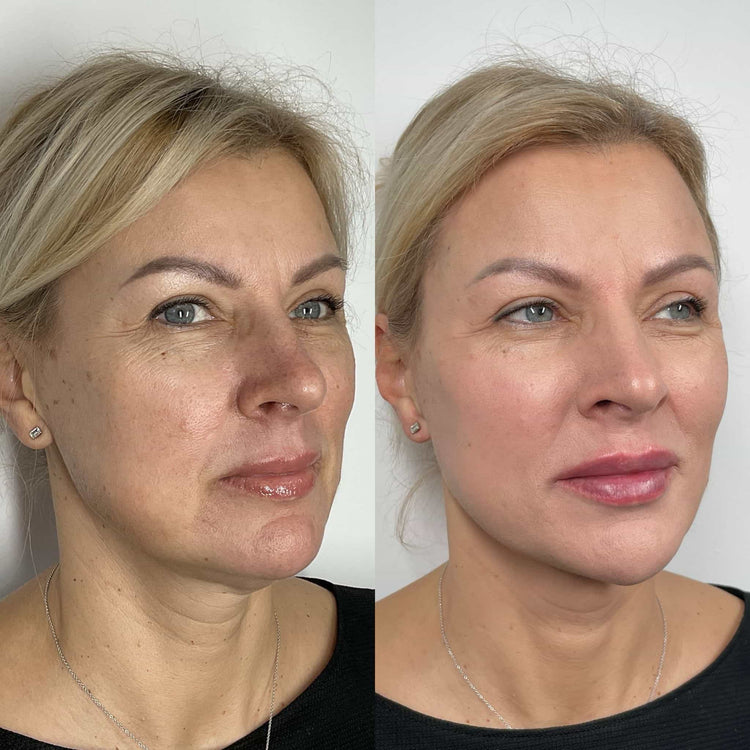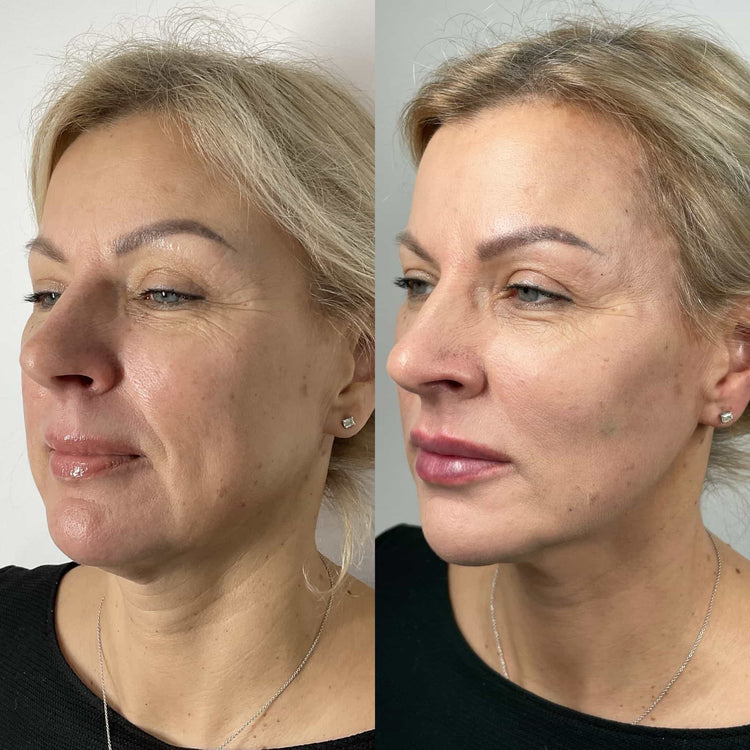Is A Non-surgical Liquid Facelift A Good Alternative To Surgery
Benefits of Non-Surgical Liquid Facelift
Considering a facelift but hesitant about surgery’s downtime and risks? A non-surgical liquid facelift might be your answer. This innovative procedure utilizes injectable dermal fillers and neurotoxins to subtly rejuvenate facial features, achieving a refreshed and youthful appearance without the need for incisions or lengthy recovery periods.
Reduced Appearance of Fine Lines and Wrinkles
One of the most significant benefits of a non-surgical liquid facelift is its ability to significantly reduce the appearance of fine lines and wrinkles. Dermal fillers, often made from hyaluronic acid, can be strategically injected into areas like smile lines, nasolabial folds, and forehead creases to plump up the skin and smooth out those unwanted lines.
Neurotoxins, such as Botox, work by temporarily paralyzing the muscles responsible for wrinkle formation. By relaxing these muscles, neurotoxins prevent further deepening of existing wrinkles and even diminish the appearance of dynamic wrinkles – those that form with facial expressions.
Improved Skin Tone and Texture
Beyond smoothing out wrinkles, a non-surgical liquid facelift can lead to improved skin tone and texture. Dermal fillers not only plump the skin but also contribute to a more even complexion by filling in depressed areas and restoring volume. This results in a smoother, more radiant appearance.
Additionally, by relaxing facial muscles with neurotoxins, the risk of future wrinkles is reduced, leading to improved long-term skin texture.
Enhanced Facial Volume and Contour
A non-surgical liquid facelift offers several benefits for enhancing facial volume and contour, making it an appealing alternative to traditional surgical facelifts.
- Dermal fillers strategically placed can add volume to areas like the cheeks, lips, temples, and jawline, restoring lost fullness and creating a more youthful appearance.
- These injectables also help to contour facial features by defining the cheekbones, slimming the nose, and enhancing the jawline.
- The result is a subtly sculpted and more balanced face that appears fuller, more defined, and rejuvenated.
Minimally Invasive Procedure
A non-surgical liquid facelift provides a minimally invasive approach to achieving a refreshed appearance. Unlike traditional surgical procedures, it involves the use of injectable dermal fillers and neurotoxins to subtly enhance facial features.
One key advantage is the reduction of wrinkles. Dermal fillers, often composed of hyaluronic acid, can be injected into areas such as smile lines, nasolabial folds, and forehead creases to smooth out these visible signs of aging.
Neurotoxins like Botox work by temporarily paralyzing facial muscles that contribute to wrinkle formation. This helps prevent further deepening of existing wrinkles and diminishes the appearance of dynamic wrinkles – those that develop with facial expressions.

Beyond wrinkle reduction, a liquid facelift can improve skin tone and texture. Dermal fillers not only plump the skin but also create a more even complexion by filling in depressions and restoring volume.
Furthermore, relaxing facial muscles with neurotoxins minimizes the risk of future wrinkle formation, contributing to long-term skin health and a youthful appearance.
Procedure of a Liquid Facelift
A non-surgical liquid facelift offers a minimally invasive approach to rejuvenating facial features. This procedure utilizes injectable dermal fillers and neurotoxins to subtly enhance contours, smooth wrinkles, and restore a youthful appearance without the need for surgery or extensive downtime.
Consultation and Assessment
The procedure for a liquid facelift typically begins with a consultation and assessment. During this initial appointment, a qualified medical professional will thoroughly evaluate your facial features, skin condition, and desired outcomes. They will discuss your medical history, any allergies you may have, and review your expectations for the treatment.
Based on the assessment, the practitioner will develop a customized treatment plan that outlines the specific areas to be treated and the type and amount of dermal fillers and neurotoxins needed. You will also have the opportunity to ask questions and address any concerns you may have about the procedure.
On the day of the procedure, you can expect to receive local anesthesia to ensure your comfort. The practitioner will then carefully inject the dermal fillers and neurotoxins into the designated areas using fine needles. This process usually takes around 30 to 60 minutes, depending on the extent of the treatment.
After the procedure, you may experience some minor bruising, swelling, or redness at the injection sites, which typically subside within a few days. It is recommended to avoid strenuous activity and direct sun exposure for a short period following the treatment. The results of a liquid facelift are generally visible immediately, with further improvement over the following weeks as the filler settles.
Injection Process
A non-surgical liquid facelift involves injecting dermal fillers and neurotoxins into specific areas of the face to enhance appearance and minimize signs of aging.
Dermal fillers, often made from hyaluronic acid, are injected to add volume to areas like cheeks, lips, temples, and jawline, restoring lost fullness and creating a more youthful contour. They can also smooth out wrinkles by plumping up the skin.
Neurotoxins, such as Botox, temporarily paralyze facial muscles that contribute to wrinkle formation. This prevents further deepening of existing wrinkles and diminishes the appearance of dynamic wrinkles, those caused by facial expressions.
Recovery Time
A non-surgical liquid facelift typically involves two key components: dermal fillers and neurotoxins.
Dermal fillers, often made from hyaluronic acid, are injected into areas like smile lines, nasolabial folds (the lines that run from the nose to the corners of the mouth), and forehead creases. These fillers add volume, smoothing out wrinkles and restoring a more youthful contour.
Neurotoxins, such as Botox, are injected to temporarily paralyze muscles that contribute to wrinkle formation. This prevents further deepening of existing wrinkles and reduces the appearance of dynamic wrinkles, those that appear when you smile or frown.
Recovery time for a liquid facelift is relatively short compared to traditional surgery. Most patients experience minimal discomfort and can resume normal activities within a few days. There may be some mild bruising or swelling at the injection sites, but these typically subside within a week.
Candidates for a Non-Surgical Liquid Facelift
Considering a facelift but hesitant about surgery’s downtime and risks? A non-surgical liquid facelift might be your answer. This innovative procedure utilizes injectable dermal fillers and neurotoxins to subtly rejuvenate facial features, achieving a refreshed and youthful appearance without the need for incisions or lengthy recovery periods.
Age Range
A non-surgical liquid facelift is generally suitable for individuals in their 30s and beyond.
While younger individuals may experience some benefits from this procedure, it’s often more effective for those who have already begun to show signs of aging, such as fine lines, wrinkles, or loss of facial volume. The ideal age range for a liquid facelift can vary depending on individual factors like skin condition and desired outcomes.
Skin Concerns
A non-surgical liquid facelift addresses various skin concerns, primarily focusing on reducing the appearance of aging.
Fine lines and wrinkles are significantly minimized through the use of dermal fillers that plump up the skin and smooth out creases. Loss of facial volume, a common concern with aging, is addressed by restoring fullness in areas like the cheeks, temples, and jawline.
The procedure also improves skin tone and texture by creating a more even complexion and reducing the appearance of depressions.
Medical History

A medical history review is crucial before undergoing a non-surgical liquid facelift. The practitioner needs to know about any past surgeries, allergies, current medications, and health conditions.
Certain medications, such as blood thinners or those affecting collagen production, can interact with the procedure and may require adjustments to the treatment plan.
Allergies to anesthetic agents or ingredients in dermal fillers are also important to disclose, as these can lead to adverse reactions.
Health conditions like autoimmune disorders, skin infections, or bleeding disorders may necessitate a consultation with a physician before proceeding with the liquid facelift.
Risks and Side Effects
While non-surgical liquid facelifts offer numerous benefits, it’s important to be aware of potential risks and side effects. These can include bruising, swelling, redness, pain, and tenderness at the injection sites. In rare cases, more serious complications such as infections, allergic reactions, or changes in skin pigmentation may occur.
Bruising and Swelling
Bruising and swelling are common side effects of a liquid facelift and typically resolve within a few days. These side effects result from the injections causing minor trauma to the tissues.
While rare, more serious complications such as infections, allergic reactions, or changes in skin pigmentation can occur. It’s crucial to consult with a qualified medical professional who has experience performing liquid facelifts and discuss your individual risks and potential side effects.
Asymmetry
While non-surgical liquid facelifts offer numerous benefits, it’s important to be aware of potential risks and side effects. These can include bruising, swelling, redness, pain, and tenderness at the injection sites. In rare cases, more serious complications such as infections, allergic reactions, or changes in skin pigmentation may occur.
Bruising and swelling are common side effects of a liquid facelift and typically resolve within a few days. These side effects result from the injections causing minor trauma to the tissues.
While rare, more serious complications such as infections, allergic reactions, or changes in skin pigmentation can occur. It’s crucial to consult with a qualified medical professional who has experience performing liquid facelifts and discuss your individual risks and potential side effects.
Infection Risk
While non-surgical liquid facelifts offer numerous benefits, it’s important to be aware of potential risks and side effects. These can include bruising, swelling, redness, pain, and tenderness at the injection sites. In rare cases, more serious complications such as infections, allergic reactions, or changes in skin pigmentation may occur.
Bruising and swelling are common side effects of a liquid facelift and typically resolve within a few days. These side effects result from the injections causing minor trauma to the tissues.
While rare, more serious complications such as infections, allergic reactions, or changes in skin pigmentation can occur. It’s crucial to consult with a qualified medical professional who has experience performing liquid facelifts and discuss your individual risks and potential side effects.
Cost and Duration of Results
One significant consideration when evaluating a non-surgical liquid facelift is the cost and duration of results. The price varies depending on the specific areas treated, the amount of filler used, and the practitioner’s expertise.
Average Cost Range
The average cost range for a liquid facelift can be anywhere from $500 to $3,000 or more.
Keep in mind that this is just an estimate, and your actual cost may vary. Factors like the amount of filler needed, the number of areas treated, and geographic location can all influence the price.
The results of a liquid facelift typically last between six months to two years. This is because dermal fillers are gradually absorbed by the body over time.
Neurotoxin effects usually last around three to four months, so you may need repeat injections to maintain the results.
Length of Results
The cost of a non-surgical liquid facelift can vary significantly depending on several factors, including the extent of treatment, the type and amount of dermal fillers used, and the practitioner’s experience. On average, expect to pay between $500 to $3,000 or more.
Results from a liquid facelift typically last for six months to two years, as the hyaluronic acid in dermal fillers is gradually absorbed by the body over time. Neurotoxin effects are generally shorter-lasting, lasting around three to four months, so repeat injections will be needed to maintain the results.
Book your Non-Surgical Liquid Facelift treatment with Dr. Laura Geige at It’s Me & You Clinic
- Upper Face Anti Wrinkle Treatment Near Hersham, Surrey - June 5, 2025
- Nefertiti Neck Lift Treatment Near Kingston Upon Thames, Surrey - June 5, 2025
- NCTF 135 HA Near Norwood, Surrey - June 4, 2025
